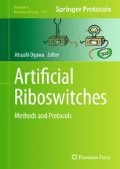Abstract
Riboswitches are composed of two regions: one for binding to the ligand (the aptamer domain) and the other for regulating the expression of the gene (the expression platform). In most riboswitches (both natural and artificial), a part of the aptamer domain required for ligand binding is directly involved in the regulation of expression, so that it is difficult to design other ligand-responsive riboswitches based on these riboswitches even by using artificial aptamers obtained through in vitro selection. This chapter describes a method for rationally constructing a foundational ON-riboswitch, which is easily available for the design of other ligand-dependent riboswitches, by introducing a new region (a modulator sequence: MS) in addition to the two basic regions. A facile method for preparing arbitrary molecule-dependent riboswitches based on the foundational riboswitch is also presented.
Access this chapter
Tax calculation will be finalised at checkout
Purchases are for personal use only
References
Winkler W, Nahvi A, Breaker RR (2002) Thiamine derivatives bind messenger RNAs directly to regulate bacterial gene expression. Nature 419:952–956
Mironov AS, Gusarov I, Rafikov R et al (2002) Sensing small molecules by nascent RNA: a mechanism to control transcription in bacteria. Cell 111:747–756
Blount KF, Breaker RR (2006) Riboswitches as antibacterial drug targets. Nat Biotechnol 24:1558–1564
Nudler E, Mironov AS (2004) The riboswitch control of bacterial metabolism. Trends Biochem Sci 29:11–17
Schwalbe H, Buck J, Fürtig B et al (2007) Structures of RNA switches: insight into molecular recognition and tertiary structure. Angew Chem Int Ed 46:1212–1219
Serganov A, Yuan Y-R, Pikovskaya O et al (2004) Structural basis for discriminative regulation of gene expression by adenine- and guanine-sensing mRNAs. Chem Biol 11:1729–1741
Ogawa A (2011) Rational design of artificial riboswitches based on ligand-dependent modulation of internal ribosome entry in wheat germ extract and their applications as label-free biosensors. RNA 17:478–488
Ogawa A (2011) Rational construction of eukaryotic OFF-riboswitches that downregulate internal ribosome entry site-mediated translation in response to their ligands. Bioorg Med Chem Lett 22:1639–1642
Madin K, Sawasaki T, Ogasawara T, Endo Y (2000) A highly efficient and robust cell-free protein synthesis system prepared from wheat embryos: plants apparently contain a suicide system directed at ribosomes. Proc Natl Acad Sci U S A 97:559–564
Sasaki J, Nakashima N (1999) Translation initiation at the CUU codon in mediated by the internal ribosome entry site of an insect picorna-like virus in vitro. J Virol 73:1219–1226
Shibuya N, Nishiyama T, Kanamori Y et al (2003) Conditional rather than absolute requirements of the capsid coding sequence for initiation of methionine-independent translation in Plautia stali intestine virus. J Virol 77:12002–12010
Pfingsten JS, Costantino DA, Kieft JS (2006) Structural basis for ribosome recruitment and manipulation by a viral IRES RNA. Science 314:1450–1454
Ogawa A (2009) Biofunction-assisted sensors based on a new method for converting aptazyme activity into reporter protein expression with high efficiency in wheat germ extract. ChemBioChem 10:2465–2468
Jenison RD, Gill SC, Pardi A, Polisky B (1994) High-resolution molecular discrimination by RNA. Science 263:1425–1429
Mathews DH, Disney MD, Childs JL et al (2004) Incorporating chemical modification constraints into a dynamic programming algorithm for prediction of RNA secondary structure. Proc Natl Acad Sci U S A 101:7287–7292
Acknowledgments
This work was supported by ‘Special Coordination Funds for Promoting Science and Technology’ and ‘Grant-in-Aid for Scientific Research on Innovative Areas’ from the Ministry of Education, Culture, Sports, Science and Technology, Japan.
Author information
Authors and Affiliations
Editor information
Editors and Affiliations
Rights and permissions
Copyright information
© 2014 Springer Science+Business Media New York
About this protocol
Cite this protocol
Ogawa, A. (2014). Rational Design of Artificial ON-Riboswitches. In: Ogawa, A. (eds) Artificial Riboswitches. Methods in Molecular Biology, vol 1111. Humana Press, Totowa, NJ. https://doi.org/10.1007/978-1-62703-755-6_12
Download citation
DOI: https://doi.org/10.1007/978-1-62703-755-6_12
Published:
Publisher Name: Humana Press, Totowa, NJ
Print ISBN: 978-1-62703-754-9
Online ISBN: 978-1-62703-755-6
eBook Packages: Springer Protocols

